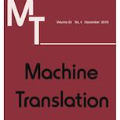Simultaneous interpretation (SI), the translation of one language to another in real time, starts translation before the original speech has finished. Its evaluation needs to consider both latency and quality. This trade-off is challenging especially for distant word order language pairs such as English and Japanese. To handle this word order gap, interpreters maintain the word order of the source language as much as possible to keep up with original language to minimize its latency while maintaining its quality, whereas in translation reordering happens to keep fluency in the target language. This means outputs synchronized with the source language are desirable based on the real SI situation, and it's a key for further progress in computational SI and simultaneous machine translation (SiMT). In this work, we propose an automatic evaluation metric for SI and SiMT focusing on word order synchronization. Our evaluation metric is based on rank correlation coefficients, leveraging cross-lingual pre-trained language models. Our experimental results on NAIST-SIC-Aligned and JNPC showed our metrics' effectiveness to measure word order synchronization between source and target language.
翻译:暂无翻译



